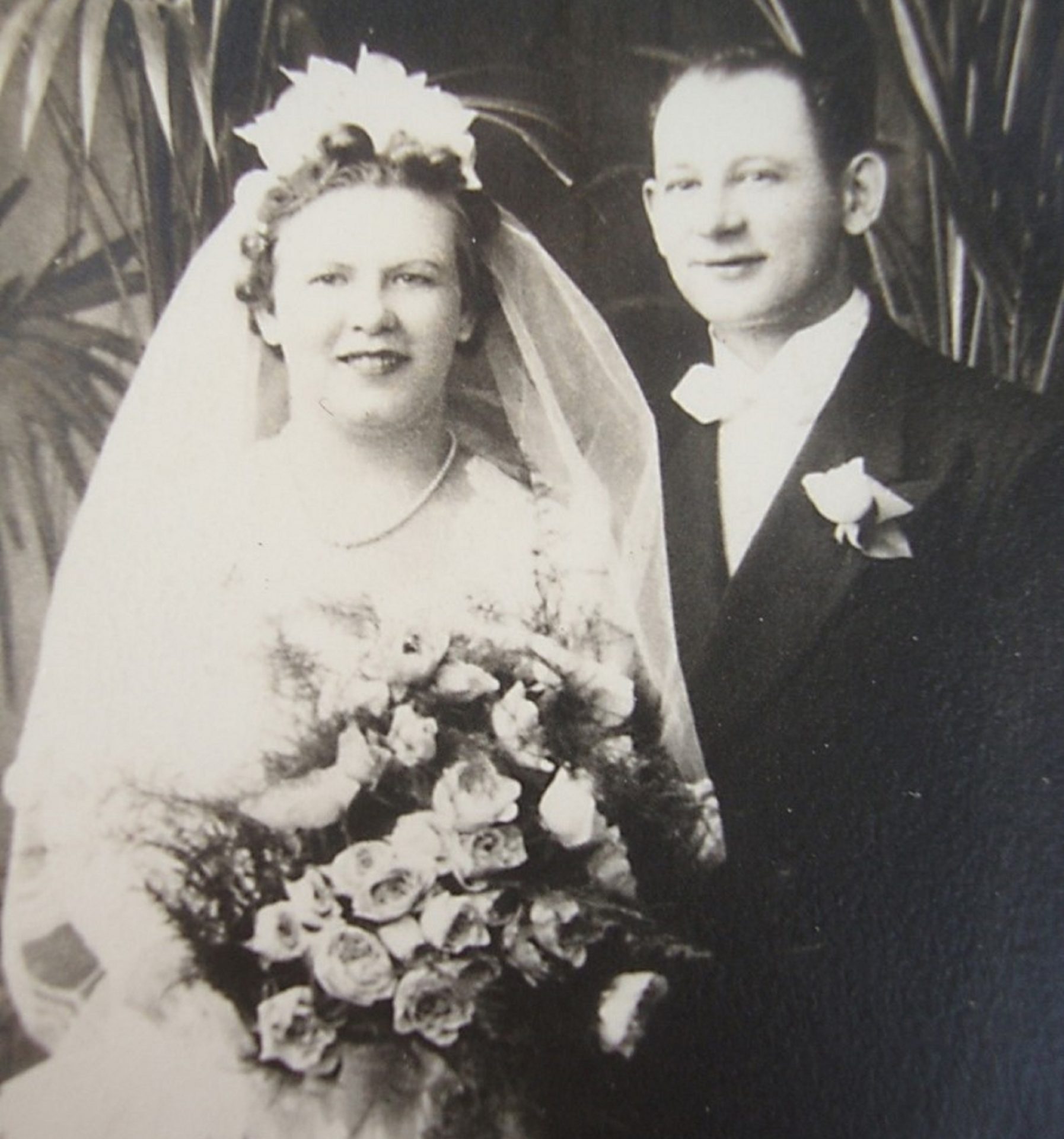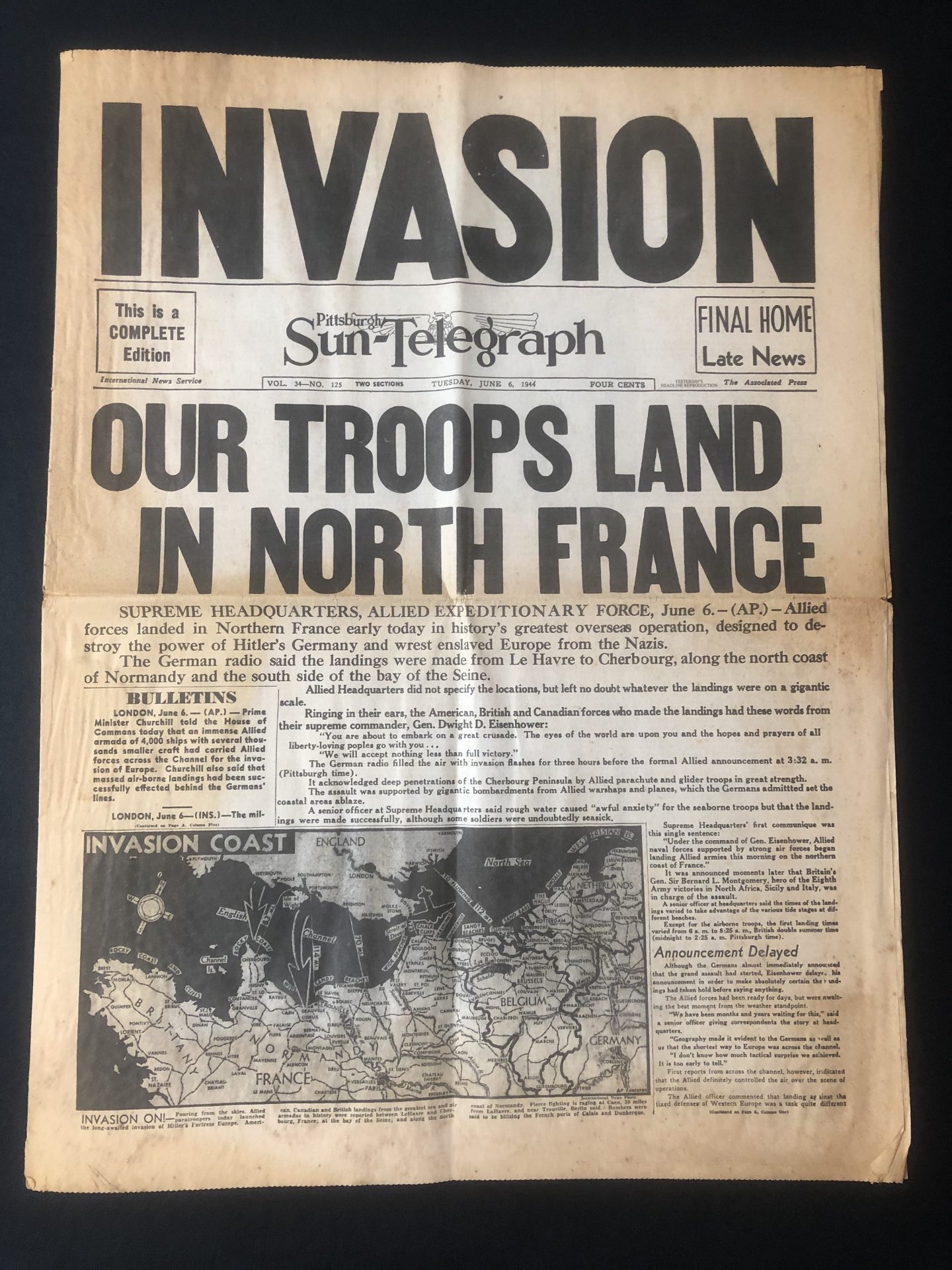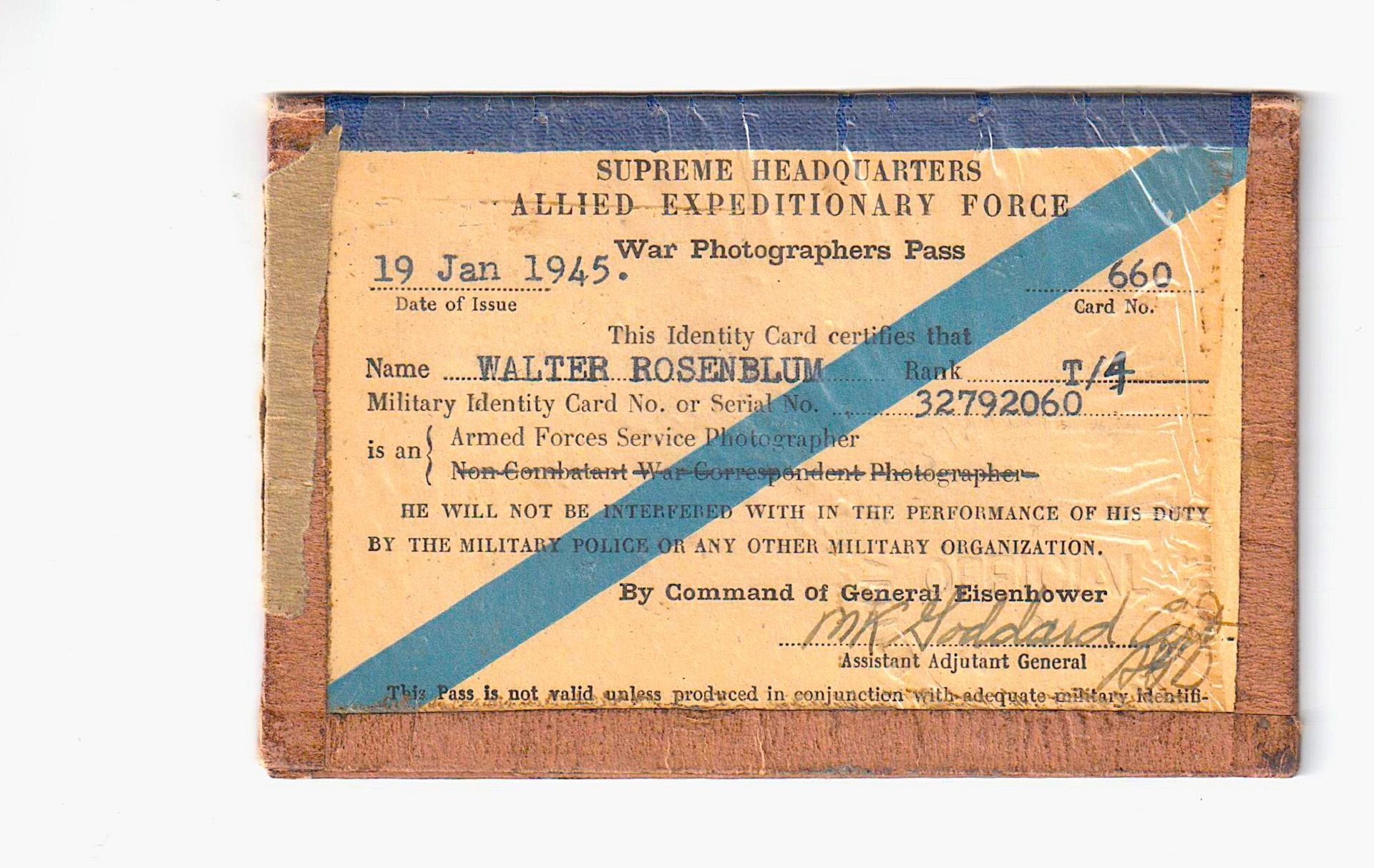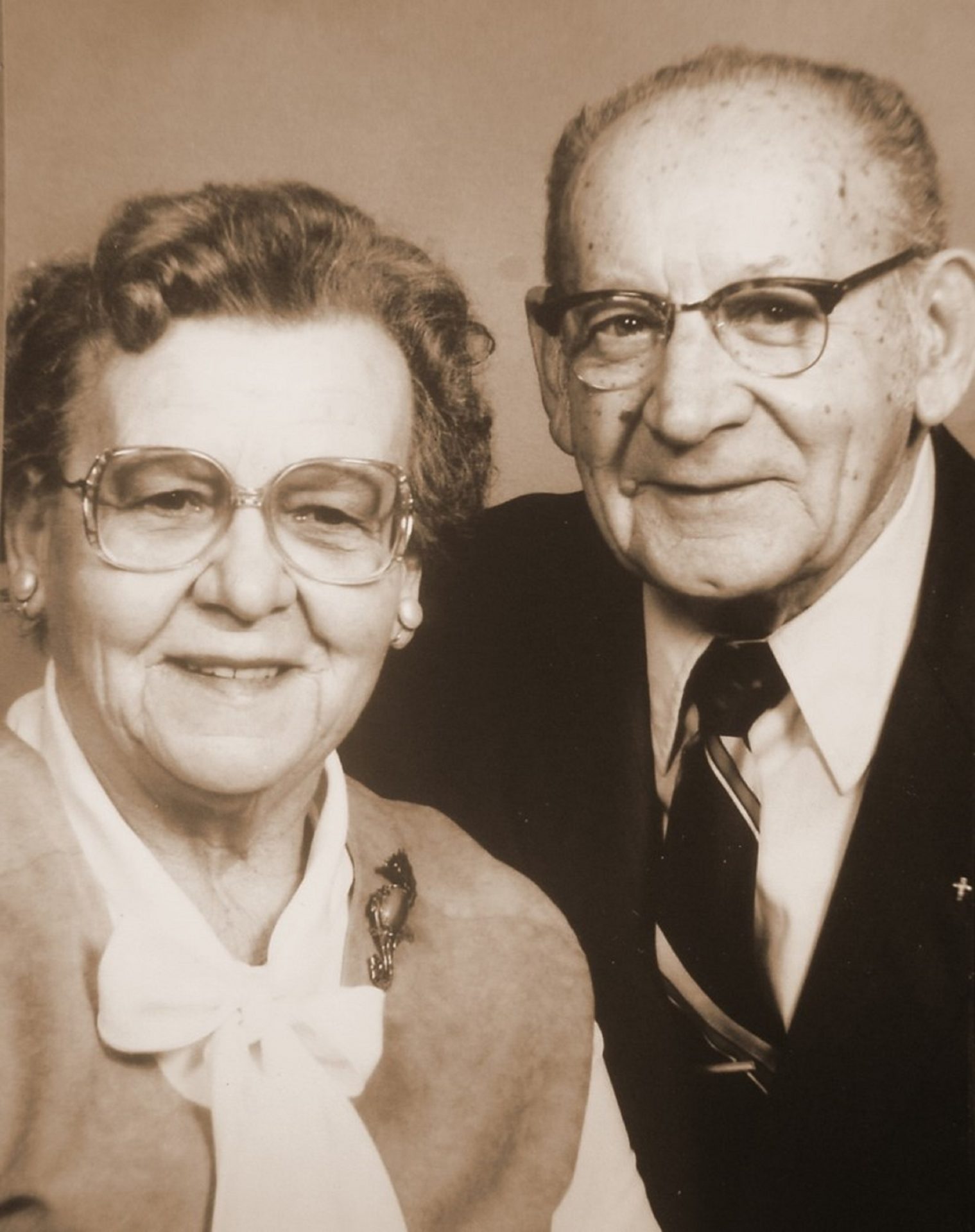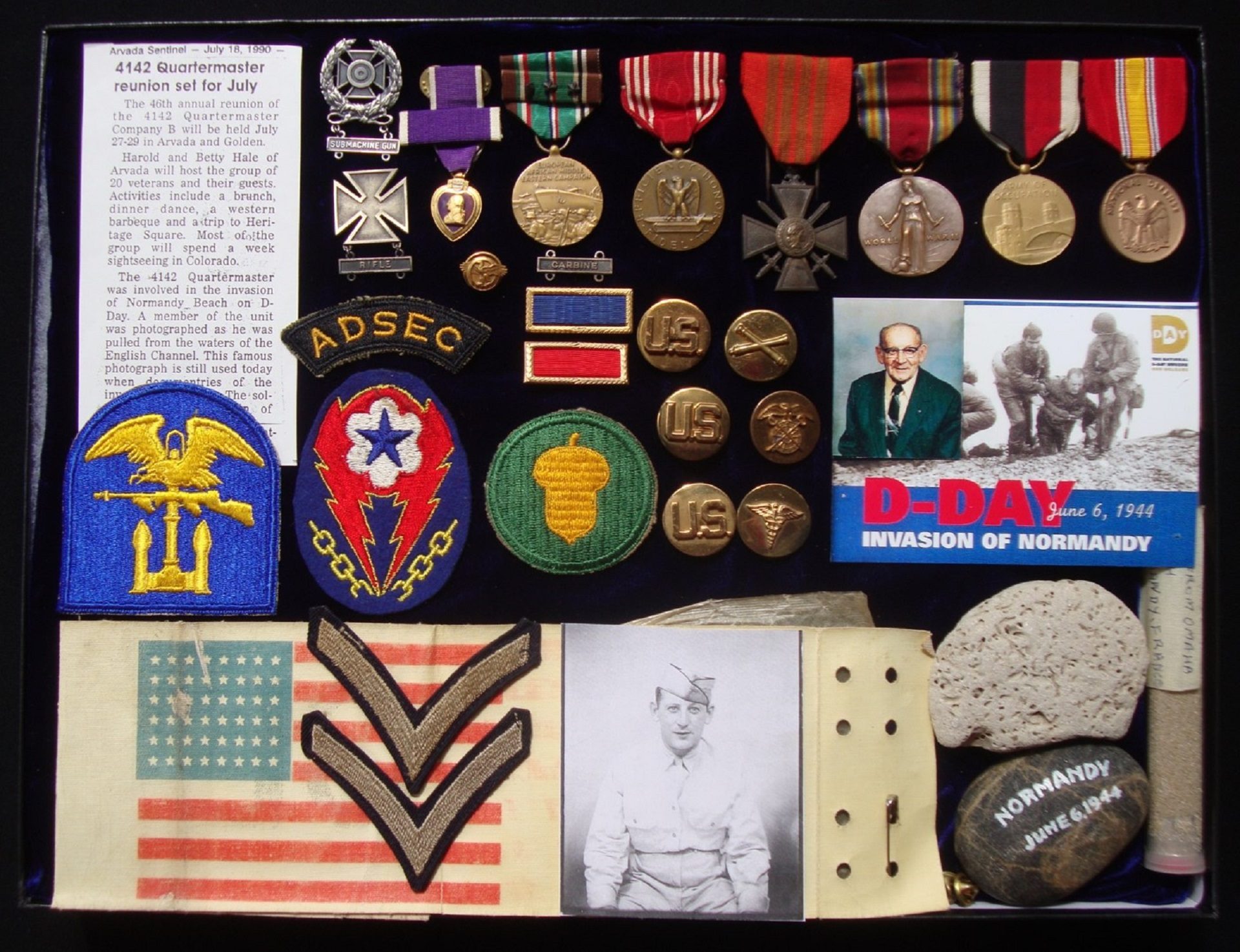How a Pennsylvania man ended up in an iconic D-Day invasion photo
To the photographers who captured the moment, it was “an act of heroism performed that we shall always remember.”
-
Tim Lambert/WITF
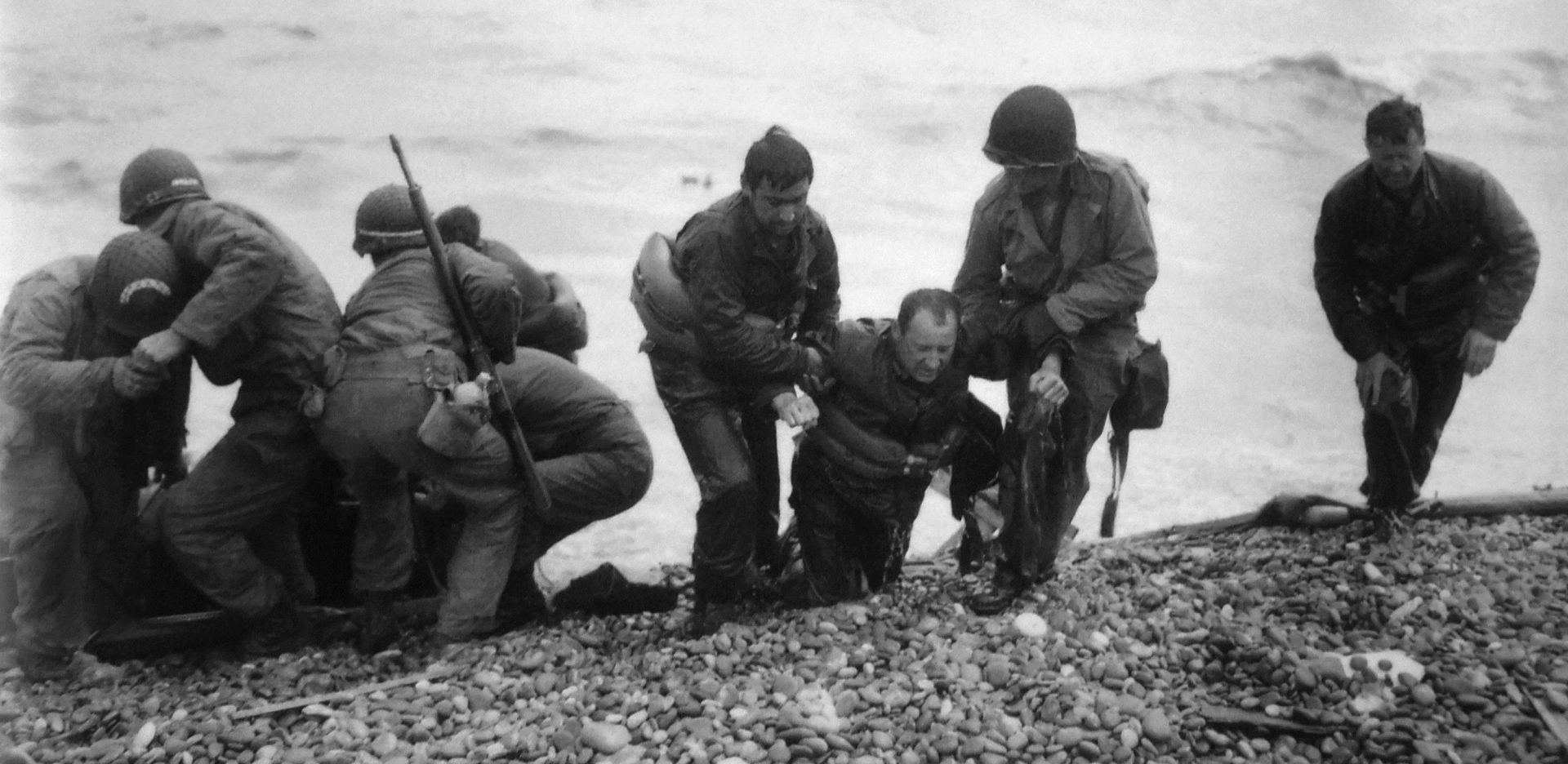
Louis Weintraub/INP Pool / AP Photo
Members of an American landing unit help their exhausted comrades ashore during the Normandy invasion on June 7, 1944. Nick Russin is pictured in the center being dragged onto shore.
The black-and-white photo shows a helmetless soldier being dragged out of the English Channel. His hands are tightly balled and his knees scrape across the rock-strewn shore. Two fellow Americans grip his arms on each side, desperately lugging the man’s almost limp body away from danger.

Louis Weintraub/INP Pool / AP Photo
Members of an American landing unit help their exhausted comrades ashore during the Normandy invasion on June 7, 1944. Nick Russin is pictured in the center being dragged onto shore.
The soldier is utterly exhausted from a life-and-death struggle with the sea. He has almost given up. Water drips from the bottom of his field jacket, just below an inflated life preserver. Within a few feet of him, another group strains to pull more men clinging to a rubber raft onshore. In the distance, formidable waves rise, and ships dot the horizon line.
He has endured the frigid, churning waters of the Channel and shelling from German troops on June 7, 1944 — D-Day +1. He is one of the lucky ones on Omaha Beach — the deadliest of the Normandy landing beaches. He has made it to France in one piece.
The photo of his rescue has come to symbolize the many elements of the invasion — fate, death, destruction, chaos, heroism, tragedy and perseverance. It’s one of the most iconic images from Omaha. It has been published in countless history books, special anniversary publications, documentaries, and even on a commemorative pistol.
To the photographers who captured the moment, it was “an act of heroism performed that we shall always remember.”
But the men in the image are rarely, if ever, identified. The name of this balding, waterlogged soldier has only been known to his rescuers, his family and maybe a few friends and fellow veterans.
It turns out, he was from Pennsylvania. How this first-generation American, who scrapped his way through the Great Depression, ended up on the rocky shores of Normandy is an improbable tale.
At one of the most critical moments in world history, he cheated death, not once, not twice, but three times.
THE SOLDIER
The day was June 7, 1944.
As he prepared to climb down the slippery rope from the ship into the swaying LVCP (Landing Vehicle Craft, Personnel) below, it may have crossed Private First Class Nicholas Russin’s mind just how far away he was from his home in Lyndora, Pa. Years earlier, he had to work odd jobs in Butler County just to feed his family, and pick up pieces of coal that tumbled off railroad cars to keep his home warm.
He was born Dec. 18, 1912, the youngest of three children. His parents arrived in Pennsylvania from Austro-Hungary in 1908, first settling in Jessup, near Scranton, and then, like thousands of immigrants before them, moving to western Pa. for work in the steel mills.
In 1928, right before the Great Depression, his father died. Nearly 16, Russin became the sole provider for his family. By the early 1930s, he was working as a cook and bartender in the Nixon Hotel in Lyndora. That’s where he met his future wife, Anna.
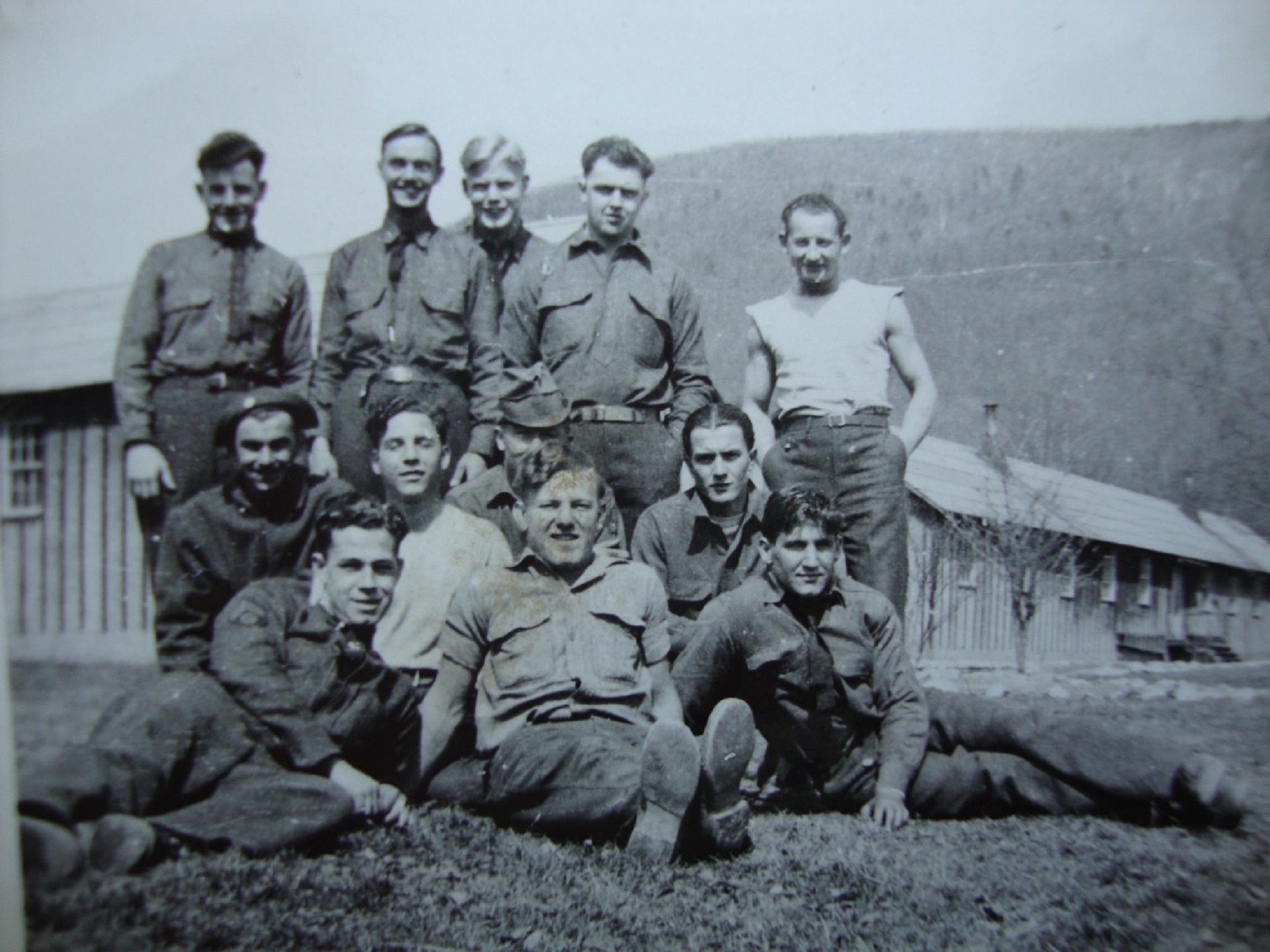
Courtesy of the Russin family
Nick Russin (back right, in a t-shirt) in the Civilian Conservation Corps.
But Russin was soon out of work again and, like other unmarried, jobless men at the time, he eventually turned to the public work relief program, the Civilian Conservation Corps (CCC). He served from September 1934 to November 1935, as a cook attached to the #1354 Company in Asaph, and #350 Company in Coudersport. Without explanation, his CCC discharge papers show he was AWOL July 3-8, 1935. Nevertheless, he received an honorable discharge from Fort Hoyle, Maryland. The reason cited was he had found other employment.
On the other side of the Atlantic, Germany had secretly been rebuilding its military, which had been strictly limited in the wake of its defeat in World War I. The Nazi invasion of Poland in 1939 led to all-out war in Europe. The U.S. remained on the sidelines, until Dec. 7, 1941, when the Japanese attacked Pearl Harbor.
Russin had a problem — he wanted to join his friends who were enlisting in the military. But he didn’t have anyone to care for his mother if he went off to war. In 1942, he married Anna, who promised to look after her mother-in-law.
Russin joined the armed services in March 1943 with his best friend from Lyndora, John Furka. Nick, who at 30 was older than the average soldier, picked the Army, while Furka signed up with the Navy.
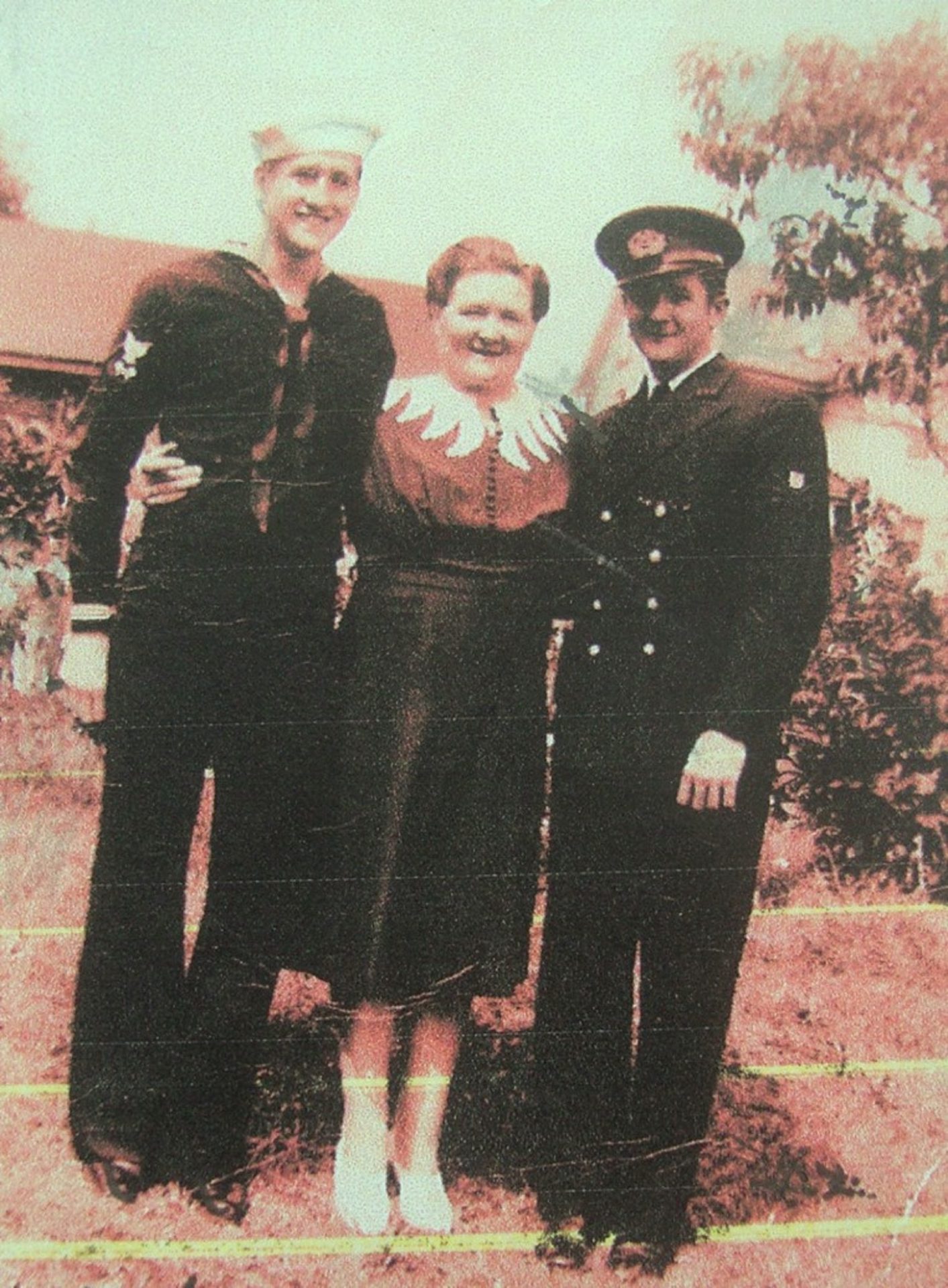
Courtesy of the Russin family
John Furka, left, poses for a photo with his mother and one of his brothers.
He was initially assigned to an artillery unit, but a family tale relates an incident that may have led to his transfer to the Engineers Brigade. Back in Lyndora, he was known as tough, skilled amateur boxer. His training apparently kicked in when he allegedly punched an officer, which landed him in the brig. Russin was then reassigned to the 4142nd Quartermaster Service Company, 5th Engineer Special Brigade, Company B.
He soon found himself in southern England as part of the massive buildup by the Allies to begin the liberation of Europe.
On the eve of D-Day, Russin recalled, “You knew this was it. You could feel the fear and intensity in the air. Men were silent. Some were praying. Some were panicking. It seemed like forever and we’re not even on the LCVP yet.”
Climbing into the landing craft on June 7, the private first class knew he would be going to a place where people were trying to kill him. His mind may have eased a bit when he ran into a familiar face: John Furka, now a Navy 2nd Class Signalman. Here stood two of the more than 400 men from Lyndora who served in the war.
“When I was on that boat hauling Army and all that from ship-to-shore, I met three people from my own hometown. They couldn’t believe that I was taking them into the invasion. One never came back.”
— John Furka
The signalman had been with the first wave the day before. “You would never believe what you have to see when (the Germans) open up. Many times, I felt like jumping in the water. But you got through it.”
The greeting was quick. Russin was pushed toward the front as more men piled in.
“Most troops landed exhausted, soaking and seasick. The wind and tide was pulling a number of craft off course,” Furka said. “About 500 yards offshore, German artillery made progress very difficult.”
As the craft cut through the choppy Channel, a young soldier jokingly asked where they were going. Russin shouted over the noise of the motors, “Hell! Can’t ya see?”
The LCVP approached a sandbar, which the pilot needed to see. He planned to drop the ramp. “Don’t jump!” he yelled as it lowered. After all, sand bars often had deep drop-offs. At the front, Russin leapt into the surf anyway. Carrying about 100 pounds of equipment and a rifle, he sank in the cold Channel waters. It was a good eight to 10 feet to the bottom.
He pushed off the seafloor and re-surfaced, gasping for air. Furka grabbed a gaff hook and managed to catch Russin’s shoulder strap on his backpack. Straining, he dragged him back to the craft. The private’s best friend had saved his life.
The door closed and the boat headed toward the beach. Twenty-five soldiers were packed in tight, standing shoulder-to-shoulder for the entire trip. Tempers flared amid the heightened sense of urgency to make sure Omaha Beach stayed in American control.
German artillery was dropping all around.
In this video produced for PA Post, historian and founder of WW2 TV Paul Woodadge visits modern-day Omaha Beach for a look at what Russin encountered when he made it to shore.
THE ASSAULT
Operation Overlord, the largest amphibious operation ever, aimed to breach Adolf Hitler’s imposing Atlantic Wall with more than 150,000 troops from 13 countries. Soldiers hailed not only from the United States and the United Kingdom, but also from places like Canada, France and Poland.
In the early morning hours of June 6, 1944, an estimated 18,000 British and American paratroopers landed along the flanks of the Normandy invasion front, ahead of the seaborne troops. They aimed to confuse German commanders and divert enemy attention from any one particular area. Their job was to secure key roads and bridges inland of the 50-mile stretch of five landing beaches, including one codenamed Omaha.
By 6:30 a.m., the first wave of landing crafts lowered their ramps and troops began moving through the German defenses — mines, metal obstacles, wooden poles angled skyward, pre-sighted kill zones, and withering artillery and machine gun fire from the heights overlooking the sand. One by one, the beaches were secured and troops began moving inland — except at Omaha.
The first wave was decimated. The second group landed, only to find dead and wounded men everywhere. The attack floundered as tenacious defenders wreaked destruction all along the five-mile beach. Several veterans said it sounded like thousands of bees were buzzing around their heads, because so many bullets were being fired at them.
But by early afternoon, the Allies had pushed the enemy off the cliffs and out of their heavily fortified, concrete emplacements and machine gun nests just enough to secure a tenuous foothold. The success came at a great cost. The number of killed, wounded or missing is estimated at 3,500.
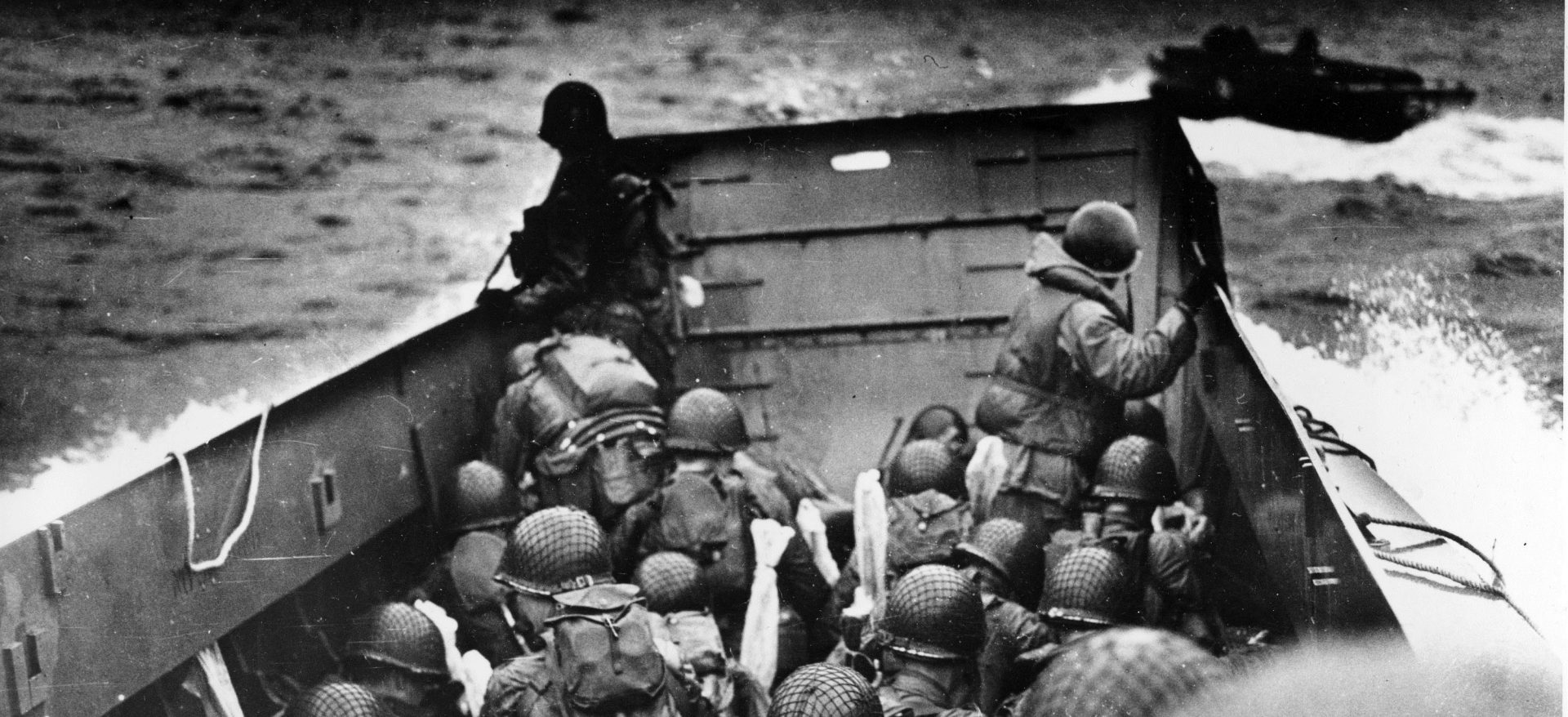
The Associated Press
In this photo provided by the U.S. Coast Guard, a U.S. Coast Guard landing barge, tightly packed with helmeted soldiers, approaches the shore at Normandy, France, during initial Allied landing operations, June 6, 1944. These barges ride back and forth across the English Channel, bringing wave after wave of reinforcement troops to the Allied beachheads.
The history lessons of Omaha don’t necessarily point to a great strategic plan or superior weapons for salvaging the attack. Much of the credit often goes to junior officers and enlisted men who led the way by improvising, taking charge of leaderless troops or simply fighting for their lives.
Some are well-known, like 26-year-old 2nd Lieutenant Jimmie Monteith of the U.S. Army’s First Division. He knocked out German machine gun positions and repeatedly cleared the area for men and eventually two tanks — on separate occasions — to reach the high ground. The young Virginian was eventually shot and killed while attacking yet another German machine gun nest. He was posthumously awarded the Medal of Honor — one of three given to men on Omaha.
The heroics of others have either been lost to time or simply shared by veterans with their families or fellow soldiers at reunions — like the men who pulled a drowning Private First Class Nick Russin out of the raging surf in the English Channel.
THE RESCUERS
It was June 6, 1944.
Second Lieutenant Walter Sidlowski of 348th Engineer C Battalion, 5th Engineer Special Brigade winced as he took a sip of coffee handed to him by a Navy crewman on the LCT (Landing Craft Tank). A cracked tooth caused a shooting pain whenever he drank hot or cold liquids. The landing craft positioned itself into a gap in the German obstacles and headed toward the Easy Red sector of Omaha.
The young officer didn’t have time to worry about the tooth. There was nothing to be done about it now. The ramp went down and members of his unit moved off to the dune-line. Jeeps with trailers followed them onto the sand.
They landed at 9:30 a.m., two hours behind schedule. Their mission was to move eastward to the Fox Green sector and open the existing exit road E-3 off the beach. Then, soldiers from the 16th Infantry, First Division, who were pinned down, could move inland.
At the time, the landings on Omaha were bordering on a disaster. Sidlowski couldn’t see any troops moving. But a small number of American infantry had gained the high ground and eliminated small arms fire and blasts from some German pillboxes. Enemy snipers, as well as machine gun and artillery crews were still active, however. Under intense fire, his team worked its way across the the shore. The remnants of what was left of the first wave were all around him. Abandoned LCTs and LCIs (Landing Craft Infantry) burned in the water.
It was a “deadly, excruciating painful existence on the beach,” he said. Sidlowski had little time to think and failed to recognize any of his fellow soldiers. Even if he did, he didn’t have time to stop and help the wounded.
The unit’s historian described the urgency in opening the E-3 exit.
“Several channels had been cleared through the obstacles on D-Day, so that it was possible to land small craft carrying equipment and personnel with some risk. Only one small craft at a time could use a channel, so the flow of supplies was much too slow. Our beach demolitions group, headed by Lt. Walter Sidlowski and Cpl. Carl A. Twill, grabbed TNT blocks and primacord and proceeded to untangle the mess of obstacles which barred the passage of supply craft to the beach. They worked the afternoon of 7 June and on through the night, stopping only long enough to eat a K ration, and by the afternoon of D plus 2 the remains of the log ramp, post, and tetrahedron obstacles, were down and piled along the beach.”
By nightfall, engineer units like his were assigned to “police the area” — basically help medics with the wounded and remove corpses from the water.
Sidlowski and photographer Walter Rosenblum recall the raft rescue at Omaha Beach on June 7, 1944, in this clip from “Walter Rosenblum: In Search of Pitt Street,” courtesy of Daedalus Productions, Inc.
On the morning of June 7, the sight of pure carnage was staggering. Debris, equipment, rubber rafts, corpses and body parts were strewn everywhere and continued to wash ashore. Sidlowski and his team resumed their efforts to remove mines and obstacles in the surf, on the beach and up to the town of Colleville-Sur-Mer (now the site of the Normandy American Cemetery). German snipers and artillery fire remained a constant threat.
Landing crafts continued to drop their ramps and deliver fresh troops, tanks, jeeps and supplies. About a dozen or more were inbound when Sidlowski noticed one stranded on a sandbar. It was one of three LCVPs about 75 to 200 yards away from shore, struggling in the choppy waters. At least one began to list and then sink. Men began swimming for their lives among the floating bodies and debris. The weight of their packs and equipment were too much for some to make it.
One of the boats was Russin’s. He was in the water — again.
“I couldn’t believe it. I was going straight to the bottom. With about 100 pounds of equipment on. I could see other guys going down,” said Russin, who stood about 5’8. “I pushed off the bottom and came up. I was trying to get rid of the equipment weighing me down. As I popped up, I threw my helmet off, gasping for air. I took in sea water, (and) went down again. I could see other men struggling.”
Sidlowski and others saw what was happening. He and a group of others decided to act. ““We swam out and took a few as we could each time and brought them back to shore. Somebody else got a long rope, which we swam out with, tied it on to the landing craft, had them hold onto the rope, and walk themselves in,” Sidlowski said. “We took as many as we could to swim in.”
For a third time, Russin went under.
His leg got caught on something. Maybe it was barbed wire.
“The water wasn’t as deep. But, I knew I wouldn’t make it and gave up….blacked out,” he said.
The men onshore grabbed an abandoned rubber boat nearby and swam out. The water was rough.
“One man had given up,” Sidlowski said. “We went out to pull that soldier to the beach and he collapsed coming ashore.”
“My next recollection was being pulled from the water, freezing, gasping and vomiting seawater. I wasn’t able to stand up.”
— Nick Russin
Sidlowski recalled: “The man was dumbfounded that he was alive.”

Nick Russin is seen being pulled ashore in this collection of still images captured from video by Val Pope.
THE PHOTOGRAPHERS
As Sidlowski and his fellow officer worked to rescue the stranded soldiers, three combat photographers watched it unfold from the beach. They were members of the U.S. Army Signal Corps., Detachment P, 162nd Signal Photographic Company HQRS, 5th Engineer Special Brigade.
Among them was someone who would become one of the most decorated photographers of the war, earning the Silver Star, Bronze Star, five battle stars and a Purple Heart. But at this moment, Private First Class Walter Rosenblum’s combat experience amounted to all of about 24 hours.
In the early morning hours the previous day, he sat 12 miles off the coast on board the USS Henrico, waiting for the order to board his landing craft. He and his colleagues worked to photograph the first assault team with the famed “Big Red One.” They departed with the words, “Cast off, coxswains. And good luck to you, men of the First Division.”
He and five others in his unit would be next. Just like Sidlowski, they were going in with the engineers in the second wave. But before that happened, Rosenblum wrote, ”The war came to us.” Wounded men were returning, as the first groups into the heavily-fortified beach were cut down by the German defenders. They instinctively started taking photos. Then, they carefully navigated the rope ladder into the LCT (Landing Craft Tank) as it tossed about in the rough Channel.
Rosenblum recalls D-Day in this clip from “Walter Rosenblum: In Search of Pitt Street,” courtesy of Daedalus Productions, Inc.
In his after-action report, written on June 21, 1944, he described, “whatever happened in front of my eyes,” in the chaotic inferno he encountered on Omaha. Rosenblum immediately saw dead bodies for the first time in his life, “many whom were caught before they had a chance to get out of the water.”
“The Germans were in the hills overlooking the beach. They zeroed in on the beach. So, people were being killed around me,” he said. “Suddenly, there are dead people in the water. The water is turning red. They’re being washed up and down by the sea.”
Under intense fire, the photographers went into action. Their lenses found the fallen, medics working on the wounded, soldiers rushing off landing crafts under intense fire, and the first captured German prisoners. The entire time, he wrote, they were “Trusting to providence to keep the bullets far from our hides, since you can’t make pictures with your head buried in a foxhole.”
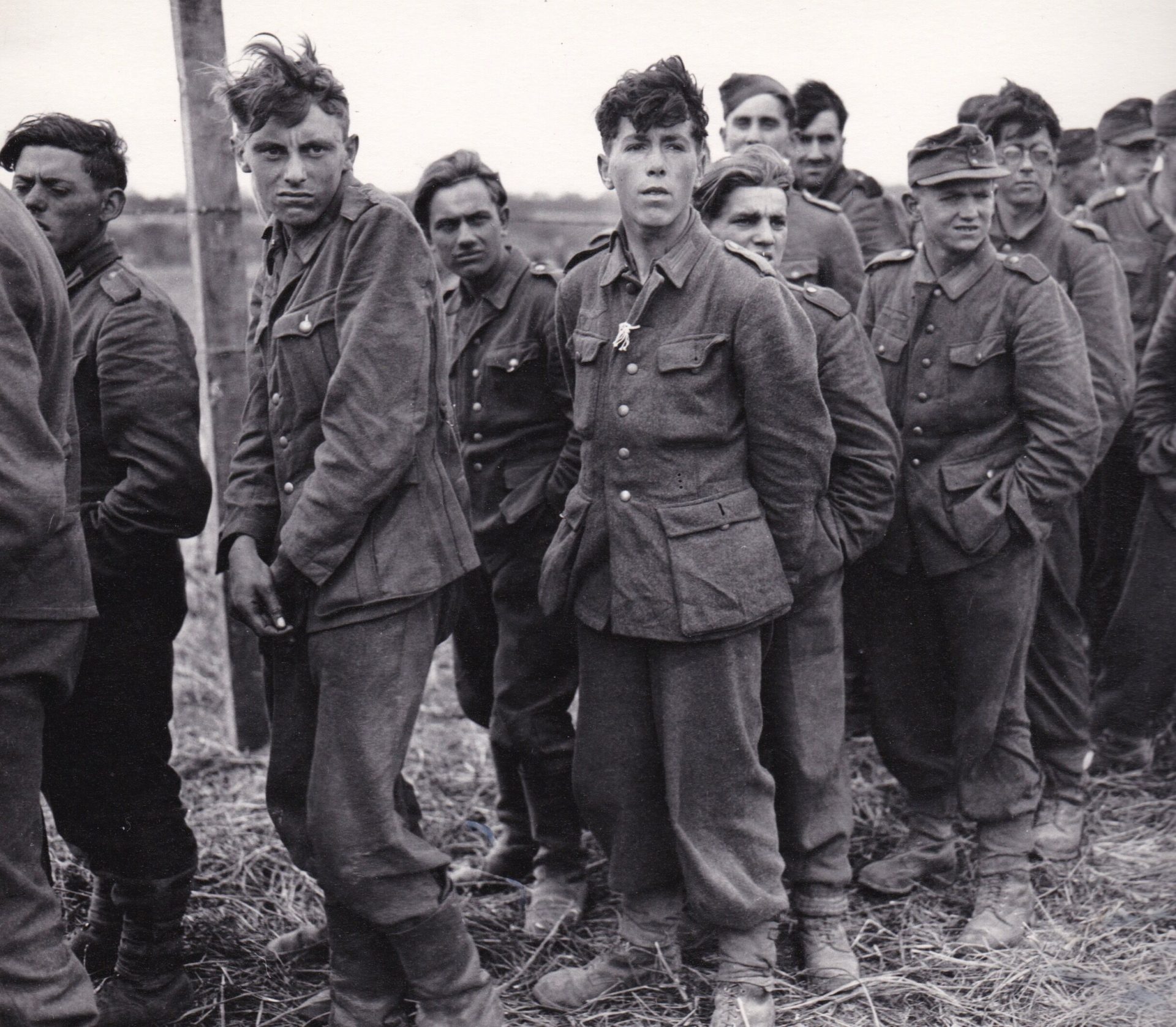
Photograph by Walter Rosenblum, US Army Signal Corps
German prisoners of war on Omaha Beach on June 7, 1944.
Slowly, as more and more American troops landed, the fate of the invasion became clearer. Previously-demoralized soldiers found ways to fight their way off Omaha and began to overtake the German defenders. Members of the 1st and 29th Divisions eventually established a small beachhead.
As night fell, the members of the 162nd Signal Photographic company found a small ravine where they could rest. They took out their notebooks and wearily began writing descriptions to their editors, who would caption their photos and movies. According to Rosenblum’s report, all their film was handed over to the chief of an LCP, who promised to safely get it to London.
It never made it. Not one person has ever seen the photos and motion picture footage they risked their lives to gather on June 6, 1944. No one knows what happened to the historic film.
The next day, however, Rosenblum and two other photographers captured a series of moments that are synonymous with the D-Day invasion. Daniel Allentuck, author of a book on Rosenblum’s WW II experiences, notes the photographer “details one of the most extensively photographed and widely seen action sequences of the war.”
As the sun rose on June 7, the group of photographers set out to capture the morning after D-Day.
“It wasn’t a pretty picture. War never is,” Rosenblum would write two weeks later.
Dead and grievously wounded men were still on the beach, troops were landing, equipment was being unloaded, and roads were being built. They walked the stones and sand of Omaha, while occasionally under German fire, with the “plop of an 88, landing without rhyme or reason anywhere along the beach.”
At 10 a.m. on the cold, blustery morning (“more January than June”), Rosenblum, still photographer Private Louis Weintraub and movie photographer Sergeant Val C. Pope saw a landing craft in trouble, men struggling in the Channel and a crowd of soldiers trying to save their comrades.
This archival footage shot by Pope shows soldiers coming to the aid of those aboard a wrecked landing craft. Russin can be seen on the right side of a raft, and then being pulled ashore by two other soldiers.
They raised their cameras.
“A shell had hit an LCVP and she was left sinking about 200 yards out at sea. Those on decks who had managed to survive the shell, held on for dear life to the hull of the boat which was all that was left afloat,” Rosenblum wrote.
A raging sea pounded the hell out of them…Two lieutenants of the 348th Engineer Combat Bn. wandered down the beach and saw the goings on. In a minute, they were both stripped nude. And disregarding the freezing weather, and the cold water, they got a rope, had some men hold one end on the shore, and swam the other end out to the men on the hull….Begging them to hold on but a bit longer, the two lieutenants swam back to shore.
Noticing a big black rubber life raft….they had two men fetch it. They tossed it in the water, and swam it down to the sinking hull. All this among waves which towered five feet high. On the shore, we couldn’t understand how they had the energy to do it again, but, that’s the wonder that is man. It was quite a job. The men on the hull nowhere near had enough energy to help themselves. It was a job of treading water and lifting 170 pounds of water soaked man into a bobbing weaving life raft.
We filmed the whole action both in stills and movies. Close-ups, long shots, anything which would convey the feeling of what was going on. In order to make sure that we got everything, the two still men worked as a team….We photographed like mad.”
The sequence wasn’t ended when the boat returned to shore. First aid had to be given to the water logged men, who were more dead than alive. And still the two lieutenants wouldn’t relent….the ages of the officers? Yes, we asked them that too for our captions, 22 and 23.”
“(They were) moments etched in our minds forever. The men being pulled from the water are world famous because of both photographers in an extraordinary chaotic moment.”
— Walter Sidlowski
Everyone on the wounded craft survived.
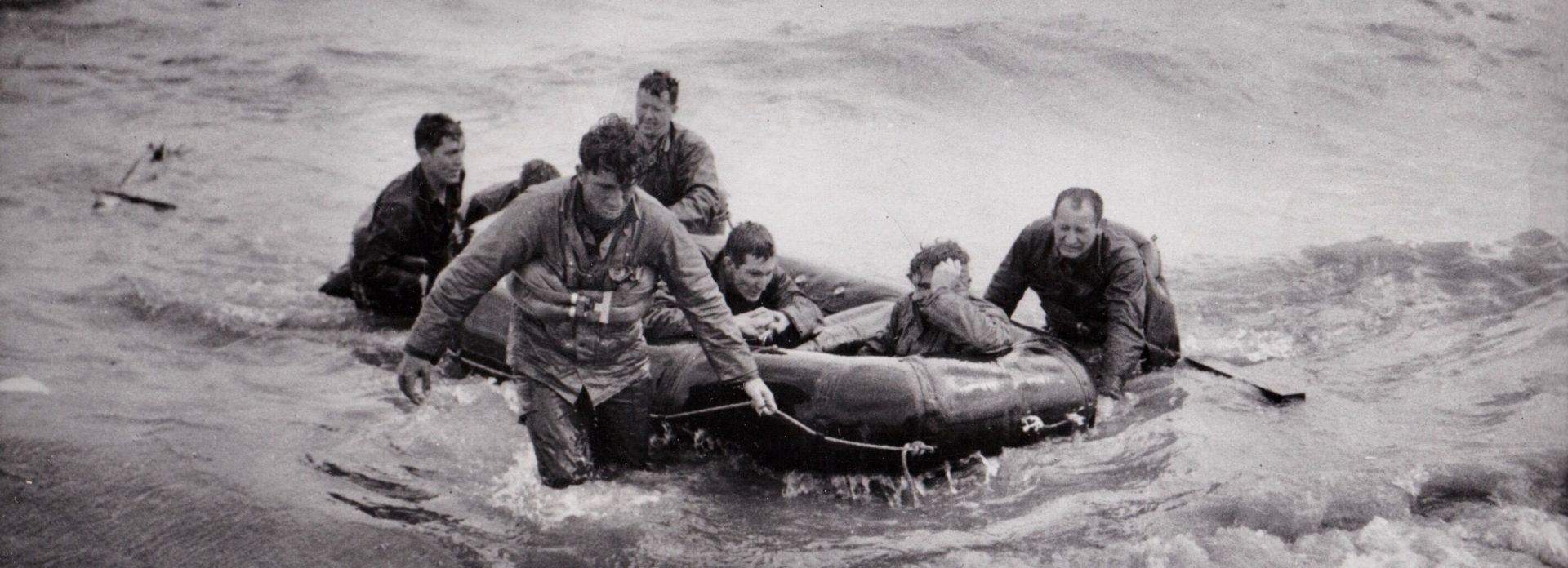
Photograph by Walter Rosenblum, US Army Signal Corps
Nick Russin, right, struggles in the heavy surf while helping rescue soldiers from a wrecked landing craft.
WHO WERE THESE MEN?
The photo from that day, credited to Louis Weintraub, became a symbol of the American fighting man’s struggles on Bloody Omaha. But the identities of some of them have only been known to a few and very rarely published.
On Russin’s left is an unknown soldier, and the man on his right remained a mystery for decades. Until one day, a man researching the photo, George Gaadt of Sewickley, Pennsylvania, looked through a book sent to him by the Russin family. On pages 62 and 63 of “Days of Destiny: The Photographs of D-Day,” Russin or his wife had apparently marked the names of the men in the photo — Sidlowski (erroneously), Russin and a 2nd Lieutenant George Carter.
On the far right is 23-year-old First Lieutenant Morris Selfe of Brooklyn (wearing glasses). Incidentally, he and Sidlowski, a fellow Brooklynite, became lifelong friends after meeting that day. On the way in to Omaha on June 6, the landing craft Selfe was in was struck by a 20 mm German round that knocked out the steering. It missed him by about 18 inches.
When he disembarked, the Germans kept destroying the flags used to mark the beach for the landing craft pilots. Selfe worked to demolish enemy fortifications, helped pick up anti-personnel mines and cut gaps in barbed wire.
On D-Day +1, he swam out to help rescue 24 soldiers stranded in a landing craft about 200 yards offshore. Then, he moved on to a second LCP and fastened a lifeline to the beach. A strong current forced him to swim in a direction to the side of the crafts, just so he could let the current pull him sideways to reach a third stranded craft.
“The experience of D-Day 1 and 2 was the roar and sound of artillery from our boats, German field artillery, nonstop machine gun fire, explosions of bombs and mines, the land crafts engines churning to get out, the silence of the men around you praying,” Selfe said. “The noise of the water crashing against the sides of the metal ramp.”
In the picture, two others are to the left, pulling the raft out of the water, that Gaadt says he believes he’s identified: John Knott, who was later killed in action, and Avon Worth. A pair of last names — Estes and Lafayette — also surfaced. But no other details are known about the men. In March, 2023, Todd Fleming wrote his grandfather, Frank H. Norley, is in a photo of the raft being pushed to shore. He is in the back of the craft to Selfe’s left. Fleming says his grandmother Dorothy knew Frank survived the invasion after seeing the picture was on the cover of the Philadelphia Inquirer in June, 1944. (The information about Norley was added to this article on March 20, 2023.)
The black-and-white film by Sergeant Pope captures how Russin reached the shore. He’s stumbling along, while grasping onto the left front side of a rubber raft filled with exhausted men. Sidlowski is in the front, slogging through the surf while pulling the raft behind him. Selfe, who managed to keep his glasses in place, is trailing it closely. Within feet of the shore, Russin lets go and drops.
The next frames show him being pulled from the water by one of the soldiers who initially appeared at the rear of the raft. Russin is either struggling to breathe or muttering something to the men holding him up. He appears ready to vomit as the film cuts out.
Sidlowski and Selfe would receive the Bronze Star for their efforts that day. Sidlowksi’s citation includes:
“The coolness, resourcefulness and heroism of Second Lieutenant Sidlowski in saving the lives of some of these men reflects high credit upon himself and upon the military service.”
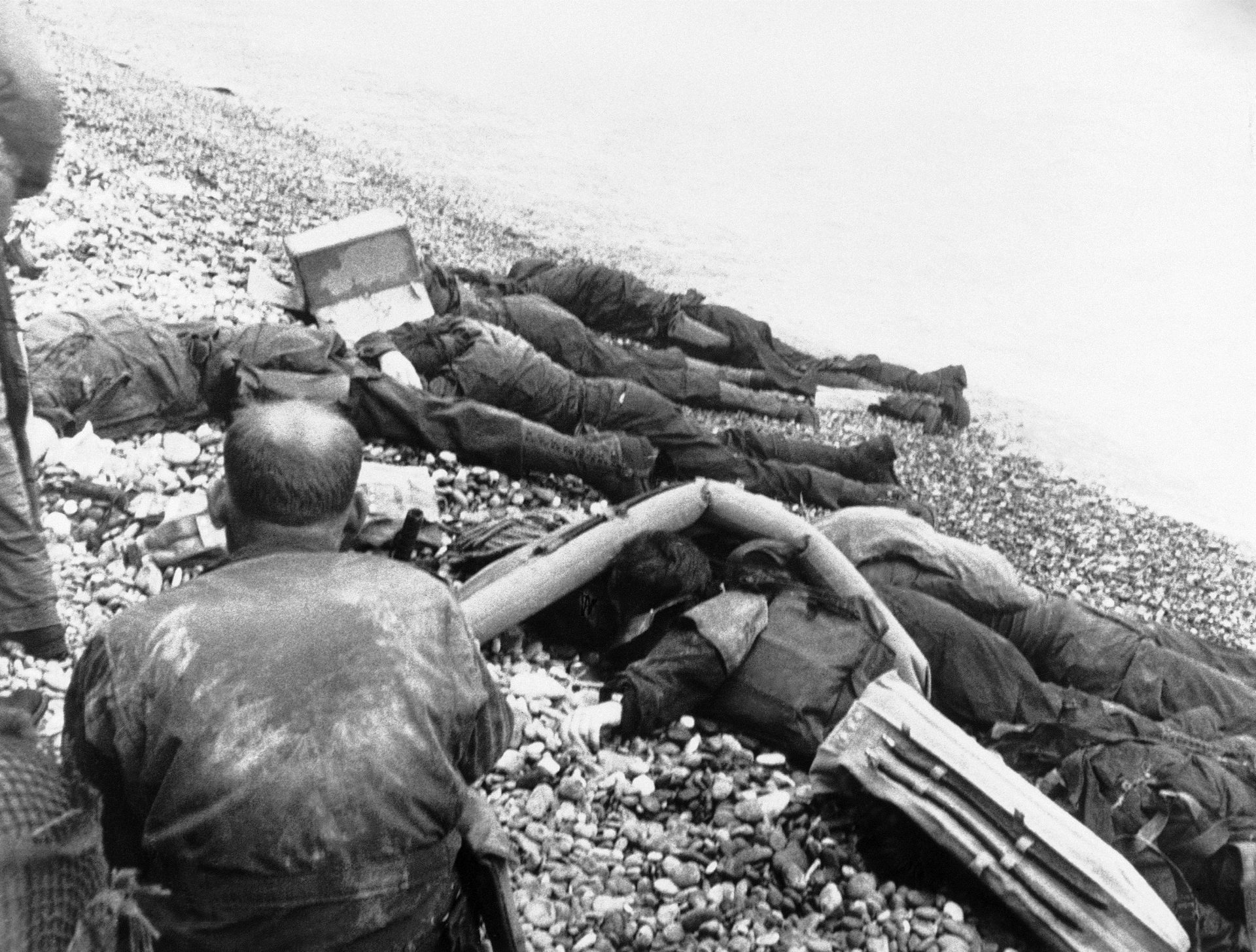
AP Photo
An American soldier, left, looks at the bodies of American assault troops who failed in their attempt to storm across a narrow strip of beach on the northern coast of France to the comparative safety of a chalk cliff on June 8, 1944, a few hundred feet from the surf.
THE SOLDIER GOES HOME
After spilling his guts of saltwater for some time, he slowly recovered. While he was on the beach, some members of his unit were close by. Russin said he told them to move closer to the seawall, but they wanted to stay put. Moments laters, an artillery shell exploded and killed them all.
All Russin remembered was that he was knocked out by the blast, which also blew all his clothes off. When he came to, some soldiers were covering him up, because they thought he was dead. A sergeant then told him to go to the medic station for treatment.
While watching medics care for badly wounded men, Russin felt his wounds were minor enough to take care of on his own. Not wanting to distract any medics from the more seriously injured men, he asked for some sulfa drugs to apply to his own wounds.
Russin headed back to the shoreline to help collect equipment and the bodies of men washing onto the stone shore. He was never treated for any wounds, so in the eyes of the U.S. Army, he was never eligible for a Purple Heart.
Private First Class Nicholas Russin would see John Furka one more time in Europe. They ran into each other in London after Germany surrendered. Russin was discharged in January, 1946, at Fort Indiantown Gap in Lebanon County, after the War in Europe ended. He returned home to Lyndora, only to see his mother pass away later that year. Russin and Anna started a family of their own — bringing Nicholas Frank into the world in 1947 and Mary Ann two years later.
Russin eased back into civilian life. He worked in a furniture factory in Etna, then, found some stability and spent the next 34 years at the Pullman Standard Car Company Forge Shop. His buddy John Furka also worked at Pullman Standard. Russin retired in 1982.
Unlike some WW II veterans, he didn’t didn’t push away his experience in the war. He attended two 5th ESB reunions (in 1987 and 1995) with his D-Day unit over the years. But the war was never far from his mind. For the rest of his life, he never rode in a boat, went swimming or drove a car.
His bedraggled face captured in the photo would show up on magazine covers, in books and on history programs through the years. But very few people knew it was him. His daughter, Mary Ann, said that as her dad aged, he would watch television every D-Day, Memorial Day and Veteran’s Day and say, “Look at that, they are pulling me out of the water again!” He also would sign his name above his face anytime he came across the famed picture.
Nicholas Russin died of complications from dementia on July 21, 1997, in the Butler State Veteran’s Hospital. He was 85. A few days before he died, with his family at his side, he asked his devoted wife Anna if his Purple Heart had arrived yet.
It never did.
EPILOGUE
2nd Lieutenant Walter Sidlowski would go on to serve in the Battle of the Bulge and return home after the war in the fall of 1945. He eventually became a NYPD detective and passed away on Aug. 5, 2014.
He himself was the subject of a stunning, memorable photo by Rosenblum. Known as “Omaha Beach Rescue,” the young lieutenant is sitting on what appears to be a dead soldier covered in a blanket. His hair is matted with sweat, while his face is covered in grime. The life preserver around his waist is still inflated. His mouth is open in a grimace with a look of almost sad resignation on his face.
“I saw this magnificent man swim out and bring some people off a sinking ship and bring them back into shore. To me, he was the picture of heroic beauty,” Rosenblum said. “I did a sequence from when he started out, when out and got them and brought them back in. It looked like a Hollywood scene, in a way, but it wasn’t. People were being killed all around us.”
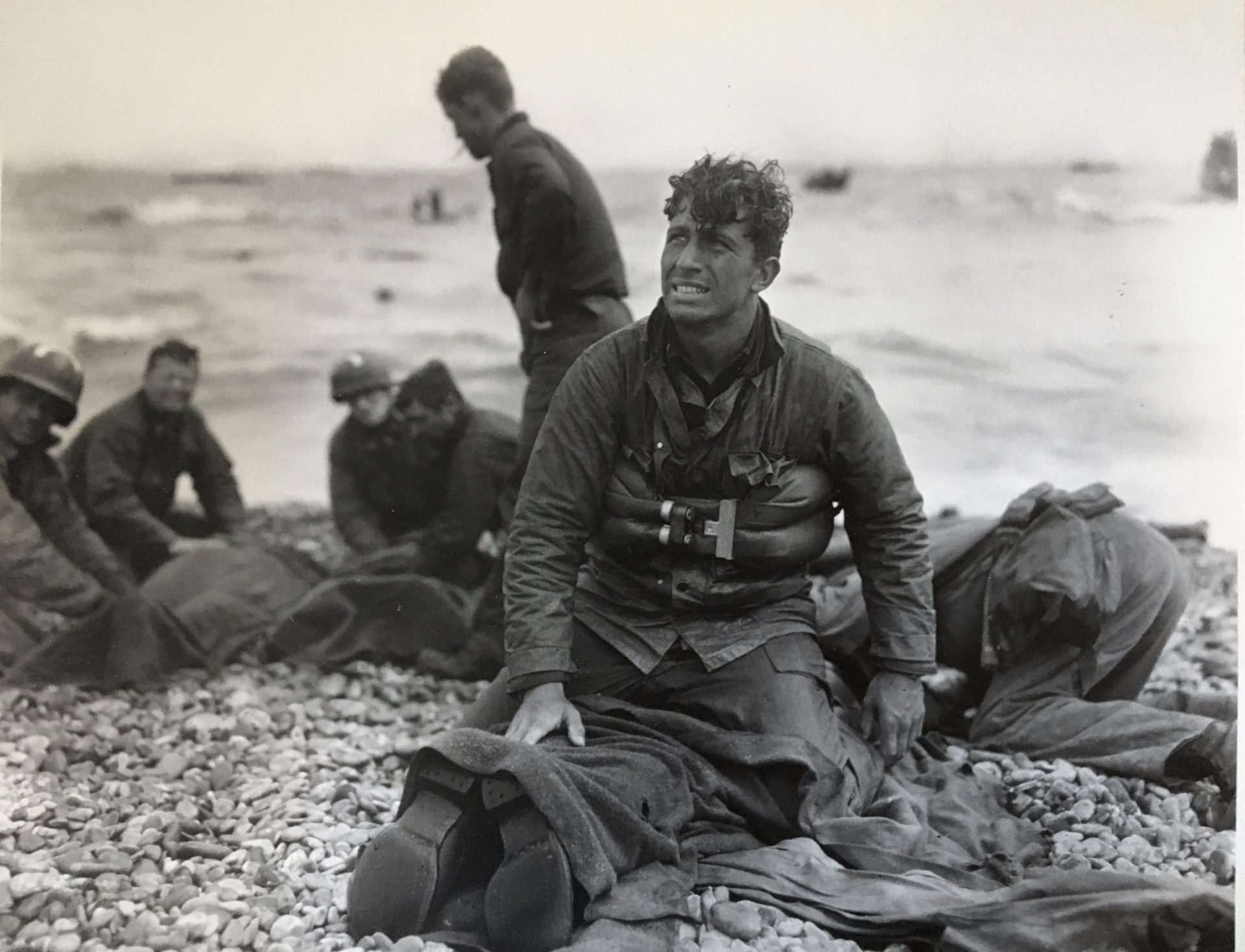
Photograph by Walter Rosenblum, US Army Signal Corps
Walter Sidlowski is seen in this photo known as “Omaha Beach Rescue.”
Through the years, the series of photographs have often been mistakenly identified as having been taken on June 6. Author Daniel Allentuck notes the captions are clearly marked as having been snapped on D-Day +1. He also points out how one officer is standing with a cigarette in his hand, without a helmet. If that officer attempted something similar the day before, he would have been an easy target for German machine gunners and snipers.
“We never could have done on the 6th what we did on the 7th,” Sidlowski said. “The intensity of fire wouldn’t let anyone or anything go back in the water to make rescues.”
Rosenblum’s closing thoughts in his after-action reports offer a window into why he believed it was worth risking his life by landing with troops early in the invasion:
Of course, the story has an ending. At least it did for us….But what about our pictures? Our job was to convey what they/we had witnessed to the millions upon millions of people back home whose sons were taking part in this war. …Yesterday, word came through our headquarters in London (Army Pictorial Service) that our pictures were fine and were used by newsreels and newspapers throughout the world. The moments of joy that followed that news was all the reward we wanted for our job. If our pictures have given some indication of the heroism of our fighting forces, if they give the public some semblance of an idea of the sacrifice , the suffering, the unending toil that is going into our war effort, then we have not been here in vain. Then we are fulfilling the function of the photographer in war time. We mirror the war for those who are not here to see.”
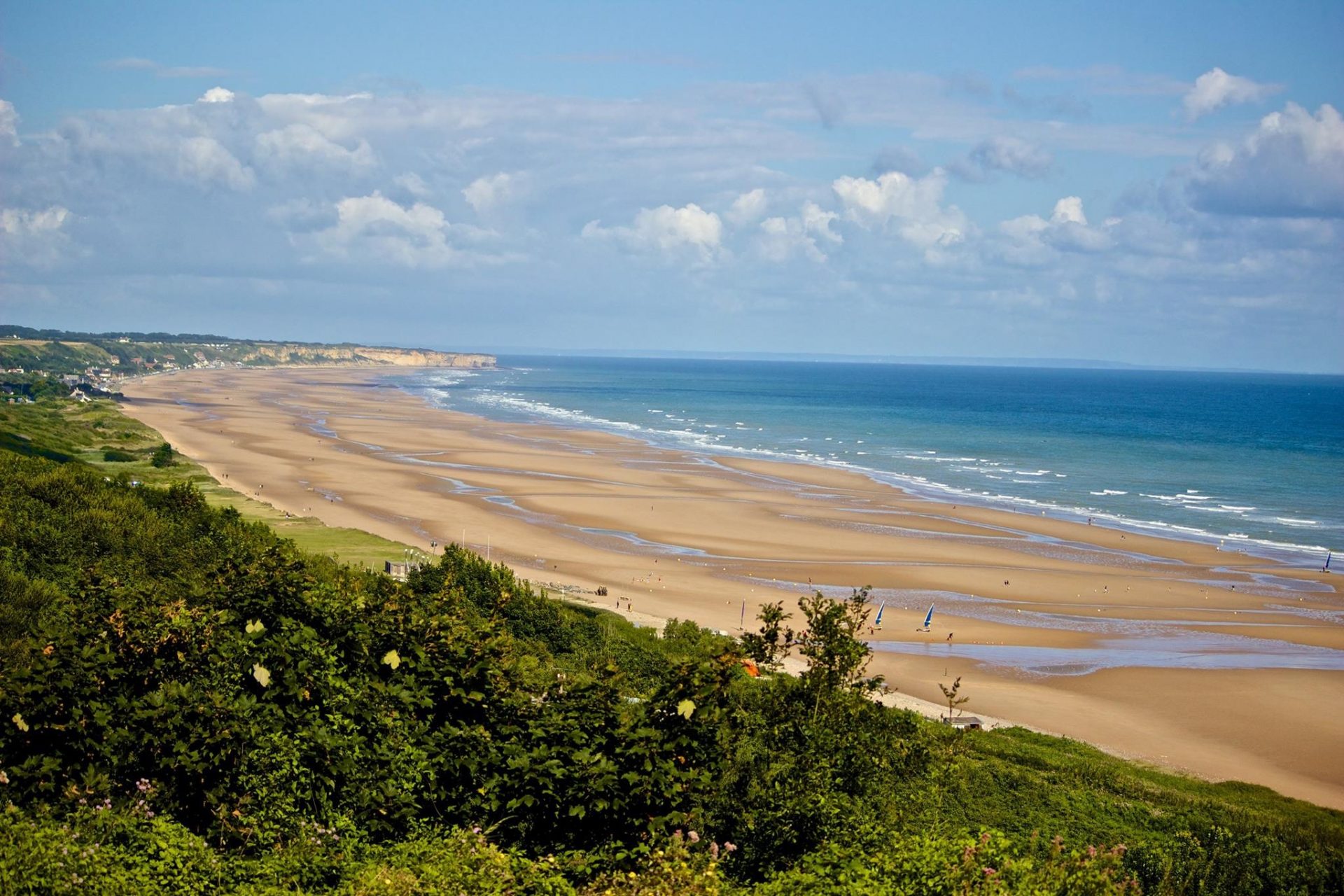
Tim Lambert / PA Post
A modern-day view of Omaha Beach.
How we told the story
This story was reported using research material from authors and historians, as well as from the families of the soldiers and sailors. In instances of conflicting memories, we did our best to match up the remembrances with what we could cross-reference with other statements and facts.
George Gaadt of Sewickley, Pennsylvania, conducted three interviews with Nicholas Russin and spoke with the families of Russin, Walter Sidlowski and John Furka.
Walter Sidlowski provided Gaadt with a typewritten, detailed account of his service in WW II.
Furka was interviewed by Jacob Osborne, a student at Slippery Rock Area School District, as part of the Veterans History Project on April 19, 2011.
Information about Sidlowski’s unit was found online, courtesy of the Bangor Public Library, World War Regimental Histories World War Collections 1946, “Pack up and move: a pictorial history of the 348th Engineer Combat Battalion.”
Morris Selfe was interviewed by a reporter from the Pagosa Sun for an article published on Veteran’s Day in 2011 in the Pagosa Sun.
Photos and video were courtesy of Nina Rosenblum, Walter Rosenblum’s daughter and director of Daedalus Productions and of the Rosenblum Photography Collection.
Rosenblum was interviewed by Survivors of the Shoah Visual History Foundation.
An interview with Rosenblum and Sidlowski was included in the documentary, “Walter Rosenblum: In Search of Pitt Street.”
Daniel Allentuck is author of the book, “They Fight With Cameras: Walter Rosenblum in WW II from D-Day to Dachau.” It contained Walter Rosenblum’s photos and after-action report in the weeks after the invasion, as well as Walter Sidlowski’s Bronze Star citation.
Sean Claxton of Normandy Insight is a battlefield guide and historian who lives in Normandy and provided resources and perspective about the actions on Omaha Beach.
Paul Woodadge, a former Normandy battlefield guide, recently launched WW2 TV, an effort to bring the battlefields to those who can’t afford to travel overseas. He shot and narrated a video from the area where the photo was taken, providing context of the challenges facing troops during D-Day and D-Day+1.
The casualty estimate cited was from Richard Anderson Jr.’s book “Cracking Hitler’s Atlantic Wall.”


